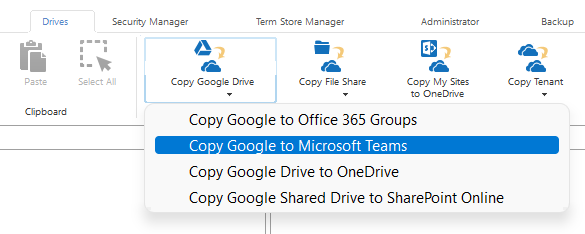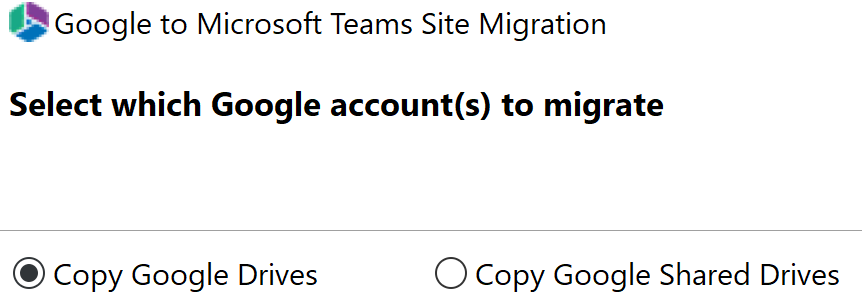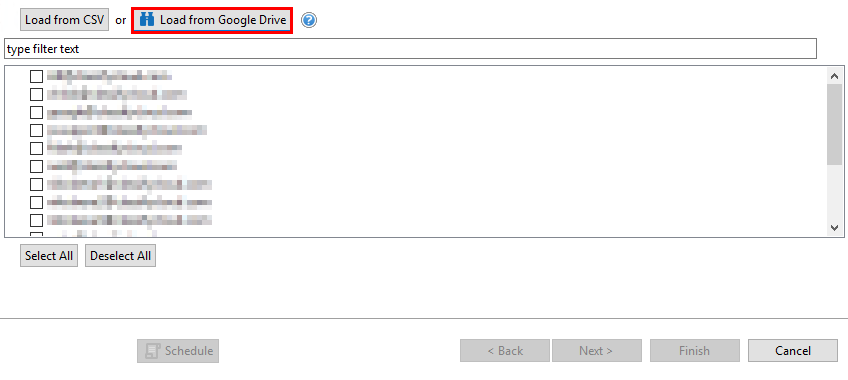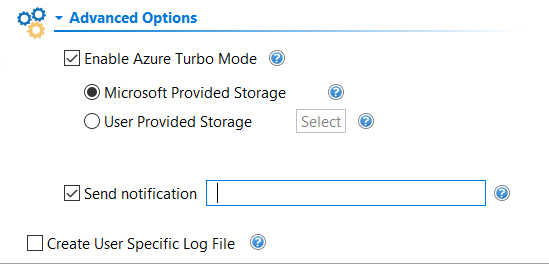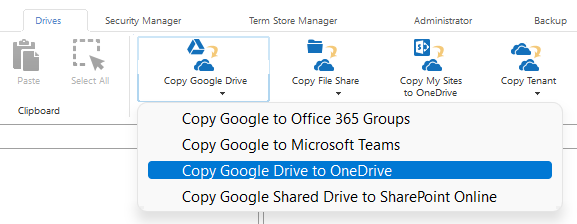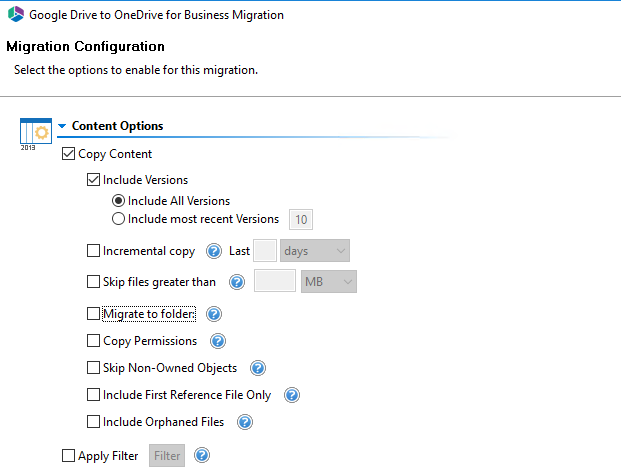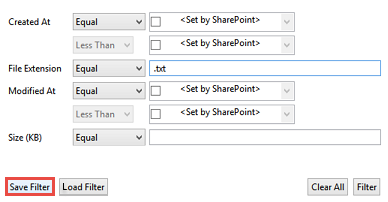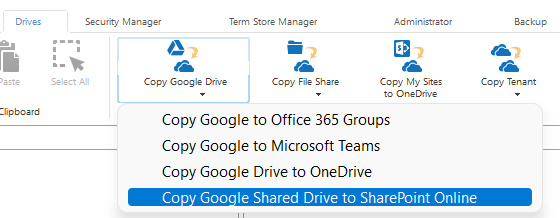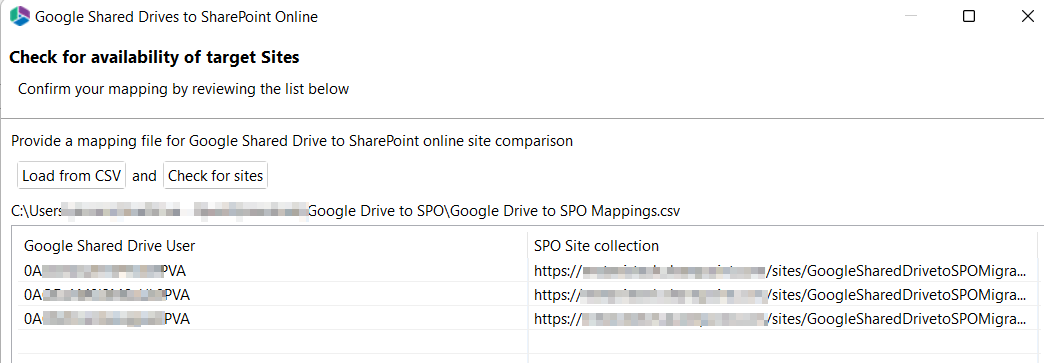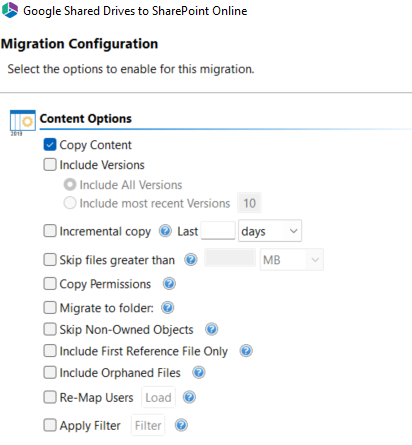Copy Google Drive to Microsoft Teams
This option allows administrators to move content from multiple Google Drives to Microsoft Teams in a single operation.
|
|
NOTE: If you have not already performed the prerequisite steps in Google, please go to this section first. Once the prerequisite configuration is complete, return here to continue with the migration. |
This operation has the following requirements for use:
·The Google Drive pre-requisites must be configured successfully prior to the migration.
·The account used to perform the migration into Microsoft Teams needs to be a minimum of a Site Collection Administrator in this Office 365 tenant.
·The person performing the migration will need to know the relationship (user mapping) between each source Google Drive account and their corresponding Microsoft Teams group name and Office 365 user account.
·The Microsoft Team Group must already exist.
To migrate the content of multiple Google Drives to Microsoft Team Groups, perform the following:
1.On the Drives tab click Copy Google Drive and select "Copy Google Drive to Microsoft Teams".
The Google Drives to Microsoft Teams Migrator wizard opens.
2.Select the Copy Google Drives option.
3.Select a Profile and give your project a name. 
4.Provide your Google Admin login, P12 Key File and Service Account in the Google connection parameters area. You can use the Google Mapping Report to gather this information. Once the values are entered, click Connect. If you receive any message other than Successfully connected to Google Drive, double check the prerequisite steps and then entered values. If you are still experiencing issues, please contact Support for assistance.
5.Specify your tenant SharePoint Administration Center URL and then click Connect. When prompted, enter your Administrator login and password. Click Connect. If you receive any message other than Successfully connected to SharePoint Admin URL, double check the URL and make sure you are supplying a Global Administrator login for this tenant. If you are still experiencing issues, please contact Support for further assistance.
6.Click Load from Google to load a list of available Google Drive accounts from your environment. Click Load from CSV to load users from a CSV file. Note that Load from CSV will allow you to load users from a CSV file, which is the faster option as only the listed users are loaded (this CSV file can be created with the help of the Google User Mapping report).
Select the accounts you want included in this migration.
|
|
NOTE: For a large number of Google Drives (>1000), the Load from Google option may take several minutes to complete. |
6.You can also choose to Load and Apply report option, which allows you to load and apply an Analyze Google Drive report, which then sets the Migration Priority for each user mentioned in the report. Click Next to continue.
|
|
NOTE: Each Migration Priority value can be changed if you click on the value in the Migration Priority columns (without user selection). It changes the migration queue but does not change the original report file. Priority in the wizard is not saved after the wizard has been closed. |
7.Check the Re-Map Users option and load your Group mapping CSV file (Please see this section for instructions on how to create a CSV Group Mapping file for Google Drive to Microsoft Teams and see this section for an overview on how to get a list of your Team Sites. Note that user mapping may also be included in this CSV).
The CSV for Group mapping is required so that the software can properly resolve the differences between your users' Google account and the corresponding Microsoft Teams Group name as well as maintain content authorship. You can also map to Teams Channels. If your user accounts differ between Google Drive and Microsoft Teams then you will want to add your user mapping to this same file. In the example below, lines 1-3 illustrate mapping a source Google Drive to a Microsoft Teams Group by name while lines 4-5 in the same file are used to map the Google user accounts to their respective Office 365 user accounts to maintain item authorship.
sales@company.com,MicrosoftTeams Group Name
marketing@company.com,MicrosoftTeams MarketingGroup
IT@company.com,IT Group
scott@company.com,swilson@contoso.com
bill@company.com,bgeorge@contoso.com
If you wish to migrate one or more source accounts to a single Group library while also remapping the user account for the purpose of metadata and sharing, please use the following format in your mapping file.
user@google.com,MicrosoftTeamsGroupName(user@contoso.com)
The software will migrate the content from the source drive "user@google.com" to the Documents library in the group "MicrosoftTeamsGroupName". The metadata and shared permissions of Google user "user@google.com" will be mapped to the Office 365 user account "user@contoso.com".
If you would like to migrate source accounts to a target Teams channel, use the following mapping.
scott@company.com,swilson@contoso.com,ChannelName
The third column in this CSV will map the users to the specific target channel.
|
|
NOTE: When using the Teams Channel, keep the following in mind: ·When adding a Teams Channel to your CSV be sure to enter the name exactly, it is case sensitive. If the name is entered improperly Essentials will assume it is a folder and will create a folder with this name on the target site collection. ·When the channel column is missing in the mapping then the migration will use the General channel by default. ·When the channel is missing on the target, then a folder will be created with the channel's name in the Shared Documents section of MS Teams. |
8.Click Check MS Team in order to begin the validation process. This process will validate that the supplied user mapping is correct (MS Teams were located) and check to determine if each Ms Team currently has a Site provisioned. Click Next.
If the group is not found, you may continue however no content for this mapping will be migrated. Alternatively, you may go back one page and remove the selected source Google Drive or modify your mapping file, reload the CSV and click the Check MS Team button again.
9.If necessary, change content and file format conversion options as described below.
Content Options
Copy Content - A flag to determine if content is or is not included with this operation. When not included the remainder of the options will become disabled.
Include Versions - The process in which Google revision history will be converted into Microsoft Teams versions. Please note that this option is only referring to the major revisions (those shown as the "less detailed revisions") and not those that are automatically generated within Google Drives (those shown as the "more detailed" revisions).
Incremental Copy - When enabled, the migration process will identify and migrate only that content which was created, modified or versioned within the defined interval (days, weeks or months).
Skip files greater than - This provides the functionality to skip all files larger than the value specified. Unit of measure is configured for MB or GB.
Migrate to folder - When this option is enabled, you can create a (or use an existing) root folder structure in the destination library where your source content will be migrated. You will need to define the path like this example:
/My Source Content/2017
In the above example, the folder "My Source Content" and subfolder "2017" will be created in the root library of your destination and all source content will be migrated to this folder location.
|
|
NOTE: The 'Migrate to folder' option can be used when migrating to a MS Teams Channel. This option will create a new sub-folder in the channel or use an existing sub-folder by this name. |
Skipped Non-Owned Objects - This addresses the possible scenario where content exists in the user's Google Drive "My Drive" area which is not owned by this user. Skipping these objects will prevent duplicate content from being migrated to the destination.
Include First Reference File Only - This option addresses the possible scenario where a user creates reference objects (links using Shift + Z in Google Drive) of a file in various locations throughout their Google Drive environment. Skipping these additional references will prevent duplicate files from being migrated to the destination by migrating only the first reference found. Please note that the "first" reference is defined by a list of parent folders returned from Google Drive and the first may not always be the same one on subsequent or incremental migrations. Please also note this option is only applicable to files, all referenced folders will be copied.
Include Orphaned Files - For the purpose of this option, an orphaned file is defined as a file that was created in a folder that was shared with this user and after the file was created, their permission to the shared folder was removed. The file still exists in the user's Google Drive, however it does not reside in any visible folder path and can only be located using the Google Drive Search Bar. When this option is enabled, the migration will identify these orphaned files and migrate them to the mapped Office 365 Group Site's Documents library. In this library, a new folder named "Orphaned Files" will be created which will contain all the migrated orphaned files.
|
|
NOTE: The use of this option can decrease overall migration performance. |
Apply Filter - Optionally, select from a series of filterable parameters to include or exclude specific content during migration.
Format Conversion:
This set of options allows you to determine how Google formatted content will be converted into Microsoft compatible content.
Advanced Options:
Enable Azure Turbo Mode: When enabled, this option utilizes Microsoft's SharePoint Online Migration API to increase the migration performance and throughput. A recommendation for optimal use of this API is larger sets of data; the more content, the better the throughput. Please review the User Manual for additional information as well as recommended configuration as this process is a resource intensive operation.
Because this API uses Azure storage as a staging area for the migration, it requires that you provide an Azure storage location. The options are to either utilize Microsoft supplied storage or to provide your own Azure storage location. If you wish to use your own Azure account, you must provide both the Azure Account Name as well as the corresponding Acces Key. If you cannot supply this information, please search our online Knowledge Base, User Manual or contact Support for additional information before proceeding or consider using the Microsoft Supplied Storage option. For more information please see the Azure Turbo Mode section.
|
|
NOTE: this function is optional and is only used to increase the migration performance to SharePoint Online or OneDrive for Business in Office 365. It does not provide any additional functionality that is not available when this option is disabled. |
·Microsoft Provided Storage: This option allows you to use Microsoft provided Azure storage instead of providing your own for the purpose of utilizing Azure Turbo Mode.
·User Provided Storage: This option allows you to provide your own Azure Storage instead of using one provided by Microsoft for the purpose of utilizing Azure Turbo Mode. It requires that you provide both your Azure Blob Storage Account Name as well as its corresponding Access Key by clicking the "Select" button to the right. If you cannot supply this information, please search our online Knowledge Base, User Manual or contact Support for additional information before proceeding.
|
|
NOTE: User Provided storage will give you access to Azure logs for a longer period of time than Microsoft provided storage. It will also allow you to perform the migration faster with less throttling. |
Send Notification: When selected, this feature will send emails to the listed recipients once Migrations are completed. Enter a specific user email address. For two or more, separate each email address with a comma. Set up User Notifications here in order to use this feature.
Create User Specific Log File - If you would like a user specific log file (.txt format) created for each migrated Google Drive, that will be saved directly to that Group's Documents library, check this option before you finish. This log file will contain all the content that was included in the migration with both source and target URLs as well as any file renaming that took place and skipped files due to lack of ownership.
NOTE: Create user Specific log file is disabled if Azure Turbo Asynchronous mode is on. Supported only for CSOM or Azure Turbo Synchronous modes.
|
|
NOTE: Content permissions are not migrated because Office 365 Group permissions are maintained and enforced by the group membership and its roles (Owners, Members and Guests). |
10. Click Finish to begin the migration process.
Please visit the following link to view the list of unsupported Google Drive objects.
Please visit the following link for an overview on how to script and schedule jobs such as Copying Google Drive to Microsoft Teams.
Copy Google Shared Drive to Microsoft Teams
This option allows administrators to move content from multiple Google Shared Drives to Microsoft Teams in a single operation.
|
|
NOTE: If you have not already performed the prerequisite steps in Google, please go to this section first. Once the prerequisite configuration is complete, return here to continue with the migration. |
This operation has the following requirements for use:
·The Google Drive pre-requisites must be configured successfully prior to the migration.
·The account used to perform the migration into Microsoft Teams needs to be a minimum of a Site Collection Administrator in this Office 365 tenant.
·The person performing the migration will need to know the relationship (user mapping) between each source Google Shared Drive account and their corresponding Microsoft Teams group name and Office 365 user account.
·The Microsoft Team Group must already exist.
To migrate the content of multiple Google Drives to Microsoft Team Groups, perform the following:
1.On the Drives tab click Copy Google Drive and select "Copy Google Drive to Microsoft Teams".
The Google Drives to Microsoft Teams Migrator wizard opens.
2.Select the Copy Google Shared Drives option.
3.Select a Profile and give your project a name. 
4.Provide your Google Admin login, P12 Key File and Service Account in the Google connection parameters area. You can use the Google Mapping Report to gather this information. Once the values are entered, click Connect. If you receive any message other than Successfully connected to Google Drive, double check the prerequisite steps and then entered values. If you are still experiencing issues, please contact Support for assistance.
5.Specify your tenant SharePoint Administration Center URL and then click Connect. When prompted, enter your Office 365 Global Administrator login and password. Click Connect. If you receive any message other than Successfully connected to SharePoint Admin URL, double check the URL and make sure you are supplying a Global Administrator login for this tenant. If you are still experiencing issues, please contact Support for further assistance.
6.Click Load from Google to load a list of available Google Drive accounts from your environment. Click Load from CSV to load users from a CSV file. Note that Load from CSV will allow you to load users from a CSV file, which is the faster option as only the listed users are loaded (this CSV file can be created with the help of the Google User Mapping report).
·Select the accounts you want included in this migration. Click Next.
|
|
NOTE: For a large number of Google Drives (>1000), the Load from Google option may take several minutes to complete. |
7.Check the Re-Map Users option and load your Group mapping CSV file (Please see this section for instructions on how to create a CSV Group Mapping file for Google Drive, and see this section to get a list of microsoft teams. User mapping may also be included in this CSV).
The CSV for Group mapping is required so that the software can properly resolve the differences between your users' Google Shared drive account and the corresponding Microsoft Teams Group name as well as maintain content authorship. If your user accounts differ between Google Shared Drive and Microsoft Teams then you will want to add your user mapping to this same file. In the example below, lines 1 illustrates mapping a source Google Shared Drive to an Microsoft Teams Group by name while line 2 in the same file is used to map the Google user accounts to their respective Office 365 user accounts to maintain item authorship.
0AFQAqumR33-Uk9PVA (this is the google shared group ID number),MicrosoftTeams Group Name
bill@company.com,bgeorge@contoso.com
If you would like to migrate source groups to a target Teams channel, use the following mapping.
0AFQAqumR33-Uk9PVA (this is the google shared group ID number),MicrosoftTeams Group Name, MicrosoftTeams Channel Name
The third column in this CSV will map the users to the specific target channel.
|
|
NOTE: When using the Teams Channel, keep the following in mind: ·When the channel column is missing in the mapping then the migration will use the General channel by default. ·When the channel is missing on the target, then a folder will be created with the channel's name in the Shared Documents section of MS Teams. |
8.Click Check MS Team in order to begin the validation process. This process will validate that the supplied user mapping is correct (MS Teams were located) and check to determine if each MS Team currently has a Site provisioned. Click Next.
If the group is not found, you may continue however no content for this mapping will be migrated. Alternatively, you may go back one page and remove the selected source Google Drive or modify your mapping file, reload the CSV and click the Check MS Team button again.
9.If necessary, change content and file format conversion options as described below.
Content Options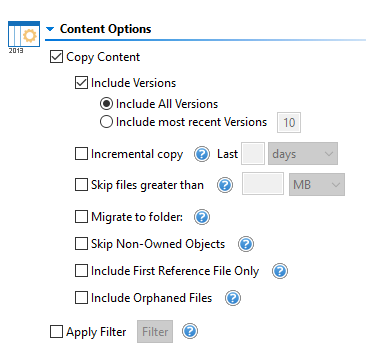
Copy Content - A flag to determine if content is or is not included with this operation. When not included the remainder of the options will become disabled.
Include Versions - The process in which Google revision history will be converted into Microsoft Teams versions. Please note that this option is only referring to the major revisions (those shown as the "less detailed revisions") and not those that are automatically generated within Google Drives (those shown as the "more detailed" revisions).
Incremental Copy - When enabled, the migration process will identify and migrate only that content which was created, modified or versioned within the defined interval (days, weeks or months).
Skip files greater than - This provides the functionality to skip all files larger than the value specified. Unit of measure is configured for MB or GB.
Migrate to folder - When this option is enabled, you can create a (or use an existing) root folder structure in the destination library where your source content will be migrated. You will need to define the path like this example:
/My Source Content/2017
In the above example, the folder "My Source Content" and subfolder "2017" will be created in the root library of your destination and all source content will be migrated to this folder location.
|
|
NOTE: The 'Migrate to folder' option can be used when migrating to a MS Teams Channel. This option will create a new sub-folder in the channel or use an existing sub-folder by this name. |
Skipped Non-Owned Objects - This addresses the possible scenario where content exists in the user's Google Drive "My Drive" area which is not owned by this user. Skipping these objects will prevent duplicate content from being migrated to the destination.
Include First Reference File Only - This option addresses the possible scenario where a user creates reference objects (links using Shift + Z in Google Drive) of a file in various locations throughout their Google Drive environment. Skipping these additional references will prevent duplicate files from being migrated to the destination by migrating only the first reference found. Please note that the "first" reference is defined by a list of parent folders returned from Google Drive and the first may not always be the same one on subsequent or incremental migrations. Please also note this option is only applicable to files, all referenced folders will be copied.
Include Orphaned Files - For the purpose of this option, an orphaned file is defined as a file that was created in a folder that was shared with this user and after the file was created, their permission to the shared folder was removed. The file still exists in the user's Google Drive, however it does not reside in any visible folder path and can only be located using the Google Drive Search Bar. When this option is enabled, the migration will identify these orphaned files and migrate them to the mapped Office 365 Group Site's Documents library. In this library, a new folder named "Orphaned Files" will be created which will contain all the migrated orphaned files.
|
|
NOTE: The use of this option can decrease overall migration performance. |
Apply Filter - Optionally, select from a series of filterable parameters to include or exclude specific content during migration.
Format Conversion:
This set of options allows you to determine how Google formatted content will be converted into Microsoft compatible content.
Advanced Options:
Enable Azure Turbo Mode: When enabled, this option utilizes Microsoft's SharePoint Online Migration API to increase the migration performance and throughput. A recommendation for optimal use of this API is larger sets of data; the more content, the better the throughput. Please review the User Manual for additional information as well as recommended configuration as this process is a resource intensive operation.
Because this API uses Azure storage as a staging area for the migration, it requires that you provide an Azure storage location. The options are to either utilize Microsoft supplied storage or to provide your own Azure storage location. If you wish to use your own Azure account, you must provide both the Azure Account Name as well as the corresponding Acces Key. If you cannot supply this information, please search our online Knowledge Base, User Manual or contact Support for additional information before proceeding or consider using the Microsoft Supplied Storage option. For more information please see the Azure Turbo Mode section.
|
|
NOTE: this function is optional and is only used to increase the migration performance to SharePoint Online or OneDrive for Business in Office 365. It does not provide any additional functionality that is not available when this option is disabled. |
·Microsoft Provided Storage: This option allows you to use Microsoft provided Azure storage instead of providing your own for the purpose of utilizing Azure Turbo Mode.
·User Provided Storage: This option allows you to provide your own Azure Storage instead of using one provided by Microsoft for the purpose of utilizing Azure Turbo Mode. It requires that you provide both your Azure Blob Storage Account Name as well as its corresponding Access Key by clicking the "Select" button to the right. If you cannot supply this information, please search our online Knowledge Base, User Manual or contact Support for additional information before proceeding.
|
|
NOTE: User Provided storage will give you access to Azure logs for a longer period of time than Microsoft provided storage. It will also allow you to perform the migration faster with less throttling. |
Send Notification: When selected, this feature will send emails to the listed recipients once Migrations are completed. Enter a specific user email address. For two or more, separate each email address with a comma. Set up User Notifications here in order to use this feature.
Create User Specific Log File - If you would like a user specific log file (.txt format) created for each migrated Google Drive, that will be saved directly to that Group's Documents library, check this option before you finish. This log file will contain all the content that was included in the migration with both source and target URLs as well as any file renaming that took place and skipped files due to lack of ownership.
NOTE: Create user Specific log file is disabled if Azure Turbo Asynchronous mode is on. Supported only for CSOM or Azure Turbo Synchronous modes.
|
|
NOTE: Content permissions are not migrated because Office 365 Group permissions are maintained and enforced by the group membership and its roles (Owners, Members and Guests). |
10. Click Finish to begin the migration process.
Please visit the following link to view the list of unsupported Google Drive objects.
Please visit the following link for an overview on how to script and schedule jobs such as Copying Google Drive to Microsoft Teams.
Copy Google Drive to OneDrive for Business
This option allows administrators to move content of multiple Google Drives to OneDrive for Business in a single move.
|
|
NOTE: If you have not already performed the prerequisite steps in Google, please go to this section first. Once the prerequisite configuration is complete, return here to continue with the migration. |
This operation requires the following permissions:
·The Google Drive pre-requisites must be configured successfully prior to the migration.
·The account used to perform the upload needs to be a minimum of Site Collection Administrator in this Office 365 tenant.
·The person performing the migration will need to know the relationship (user mapping) between each source Google Shared Drive account and their corresponding OneDrive account.
·Each user account must have either a SharePoint or OneDrive license assigned to it in Office 365.
To migrate content of multiple Google Drives, perform the following:
1.On the Drives tab click "Copy Google Drive" and select, Copy Google Drive to OneDrive.
The Google Drive to OneDrive for Business Migration wizard opens.
2.Select a Profile and give your project a name.
3.Provide your Google Admin login, P12 Key File and Service Account in the Google connection parameters area. This information is gathered directly from your Google environment, so if you have not already please refer to this section for the required steps. Once the values are entered, click Connect. If you receive any message other than "Successfully connected to Google Drive", double check the prerequisite steps and then entered values. If you are still experiencing issues, please contact Support for assistance.
4.Specify your tenant SharePoint Administration Center URL and then click Connect. When prompted, enter your Administrator login and password. Click Connect. If you receive any message other than Successfully connected to SharePoint Admin, double check the URL and make sure you are supplying a Global Administrator login for this tenant. If you are still experiencing issues, please contact Support for further assistance.
5. Click the Load From CSV or Load from Google Drive button. Note that Load from CSV will allow you to load users from a CSV file, which is the faster option as only the listed users are loaded.
Select the account you wish to migrate.
|
|
NOTE: ·For a large number of Google Drives, it's recommended to load them by pressing the Load from CSV button. |

6.You can also choose to Load and Apply report option, which allows you to load and apply an Analyze Google Drive report, which then sets the Migration Priority for each user mentioned in the report. Click Next to continue.
|
|
NOTE: Each Migration Priority value can be changed if you click on the value in the Migration Priority columns (without user selection). It changes the migration queue but does not change the original report file. Priority in the wizard is not saved after the wizard has been closed. |
7.Check the Re-Map Users option and load your user mapping CSV file (Please see this section for instructions on how to create a CSV User Mapping file for Google Drive to OneDrive). User mapping is required so the software can properly resolve the differences between your users' Google and Office 365 accounts. 
8.Click Check for users personal sites in order to begin the validation process. This process will validate that the supplied user mapping is correct (Office 365 user accounts were located) and check to determine if each user currently has a OneDrive for Business for the site provisioned. If one or more valid users do not have a OneDrive for Business site currently provisioned, select them and check Create personal sites for the selected users option. Click Next.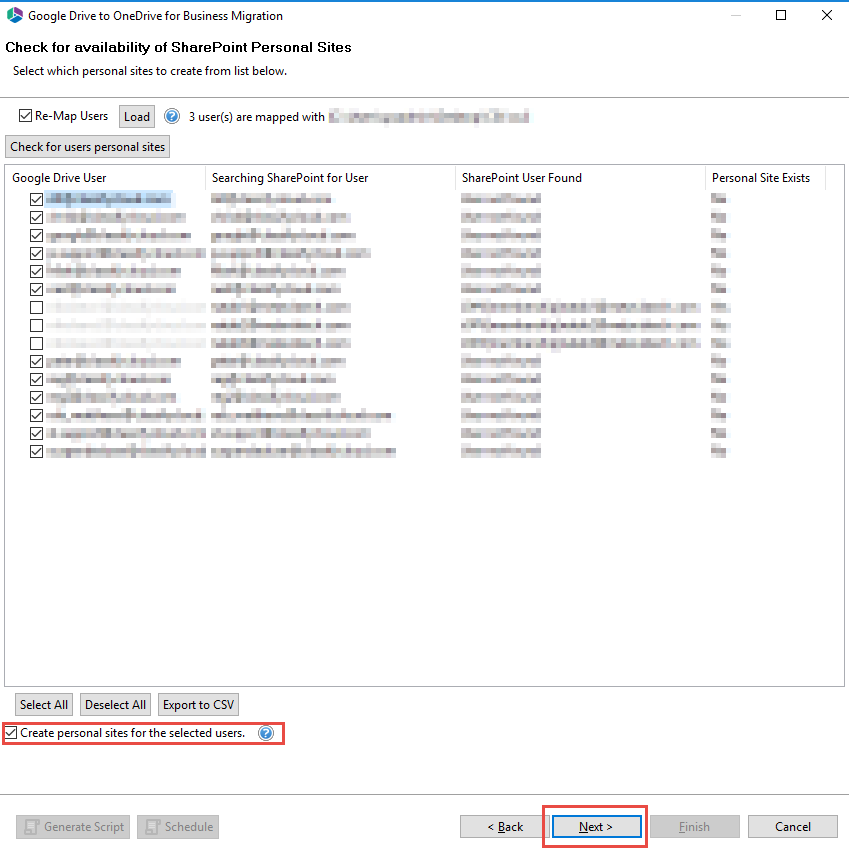
9.If necessary, change content and file format conversion options as described below:
Content Options:
·Copy Content - A flag to determine if content is or is not included with this operation. When not included the remainder of the options will become disabled.
·Include Versions - The process in which Google revision history will be converted into OneDrive for Business versions. Please note that this option is only referring to the major revisions (those shown as the "less detailed revisions") and not those that are automatically generated within Google Drives (those shown as the "more detailed" revisions). You can select whether you would like to:
oInclude All Versions
oInclude The Most Recent Versions - this option allows you to specify how many recent versions you would like to copy the content from.
·Incremental Copy - When enabled, the migration process will identify and migrate only that content which was created, modified or versioned within the defined interval (days, weeks or months). To perform a Delta migration, enter zero in the field and select days as the time period. Delta migration is designed to be used in scenarios where both the source and destination may be modified during the course of the migration.
|
|
NOTE: delta migration compares dates between source and destination to determine which content to include, so it will take more time to process than an incremental migration. |
·Skip Files Greater Than - When enabled, this option will skip any source files that are greater than the value specified (in MB or GB). An entry will be added to the post-migration log indicating which file(s) were skipped due to this configuration.
·Migrate to Folder - When this option is enabled, you can create, or use an existing, root folder structure in the destination library where your source content will be migrated. You will need to define the path, for example:
/My Source Content/2017
In the above example, the folder "My Source Content" and sub-folder "2017" will be created in the root library of your destination and all source content will be migrated to this folder location.
·Copy Permissions - When this option is selected, Google shared permissions will be converted to OneDrive for Business shared permissions.
|
Google Drive Shared Permission |
OneDrive for Business Sharing Permission |
|
Is owner |
Full Control |
|
Can edit |
Can edit (Contribute) |
|
Can comment |
Can view (Read) |
|
Can view |
Can view (Read) |
·Skipped Non-Owned Files - This addresses the possible scenario where content exists in the user's Google Drive "My Drive" area which is not owned by this user. Skipping these objects will prevent duplicate content from being migrated into OneDrive for Business.
·Include First Reference File Only - This option addresses the possible scenario where a user creates reference objects (links using Shift + Z in Google Drive) of a file in various locations throughout their Google Drive environment. Skipping these additional references will prevent duplicate files from being migrated into OneDrive for Business by migrating only the first reference found. Please note that the "first" reference is defined by a list of parent folders returned from Google Drive and the first may not always be the same one on subsequent or incremental migrations. Please also note this option is only applicable to files, all referenced folders will be copied.
·Include Orphaned Files - For the purpose of this option, an orphaned file is defined as a file that was created in a folder that was shared with this user and after the file was created, their permission to the shared folder was removed. The file still exists in the user's Google Drive, however it does not reside in any visible folder path and can only be located using the Google Drive Search Bar. When enabled, the migration will identify these orphaned files and migrate them to the mapped OneDrive for Business Documents library. In this library, a new folder named "Orphaned Files" will be created which will contain all the migrated orphaned files. The use of this option can decrease overall migration performance.
·Apply Filter - This feature allows the inclusion or exclusion of items by user defined criteria, such as date, size, file extension, file name, or file owner.
Note: the Apply Filter functionality is only applied to selected containers (i.e. site, lists or folders). If you select specific content (documents or items) then those objects will be included with the operation regardless of the filter applied. If you want to selectively include content, please select the container that this content resides in and apply the filter or apply the filter against the container first, then select the remaining content.
For the File Extension and Exclude Folders parameters only, you can use "," to set more than 1 criteria. For example, use this format "png,docx,pptx" to include multiple file extensions.
"Size" filter should have a whole number without decimals. It is recommended that users not use the operators "Equal" and "Not Equal" to avoid difficulties with accurate file size, if the file size is greater than 1 MB.
Use the "Save Filter" option to save filter settings to a file and load them in different wizards or the Profile Manager.
Format Conversion:
This set of options to determine how Google formatted content will be converted into Microsoft compatiable content.
Adanced Options:
Enable Azure Turbo Mode: When enabled, this option utilizes Microsoft's SharePoint Online Migration API to increase the migration performance and throughput. A recommendation for optimal use of this API is larger sets of data; the more content, the better the throughput. Please review the User Manual for additional information as well as recommended configuration as this process is a resource intensive operation.
Because this API uses Azure storage as a staging area for the migration, it requires that you provide an Azure storage location. The options are to either utilize Microsoft supplied storage or to provide your own Azure storage location. If you wish to use your own Azure account, you must provide both the Azure Account Name as well as the corresponding Acces Key. If you cannot supply this information, please search our online Knowledge Base, User Manual or contact Support for additional information before proceeding or consider using the Microsoft Supplied Storage option. For more information please see the Azure Turbo Mode section.
|
|
NOTE: this function is optional and is only used to increase the migration performance to SharePoint Online or OneDrive for Business in Office 365. It does not provide any additional functionality that is not available when this option is disabled. |
·Microsoft Provided Storage: This option allows you to use Microsoft provided Azure storage instead of providing your own for the purpose of utilizing Azure Turbo Mode.
·User Provided Storage: This option allows you to provide your own Azure Storage instead of using one provided by Microsoft for the purpose of utilizing Azure Turbo Mode. It requires that you provide both your Azure Blob Storage Account Name as well as its corresponding Access Key by clicking the "Select" button to the right. If you cannot supply this information, please search our online Knowledge Base, User Manual or contact Support for additional information before proceeding.
|
|
NOTE: User Provided storage will give you access to Azure logs for a longer period of time than Microsoft provided storage. It will also allow you to perform the migration faster with less throttling. |
Send Notification: When selected, this feature will send emails to the listed recipients once Migrations are completed. Enter a specific user email address. For two or more, separate each email address with a comma. Set up User Notifications here in order to use this feature.
Create User Specific Log File - If you would like a user specific log file (.txt format) created for each migrated Google Drive, that will be saved directly to that Group's Documents library, check this option before you finish. This log file will contain all the content that was included in the migration with both source and target URLs as well as any file renaming that took place and skipped files due to lack of ownership.
NOTE: Create user Specific log file is disabled if Azure Turbo Asynchronous mode is on. Supported only for CSOM or Azure Turbo Synchronous modes.
10. Click Finish to begin the migration process.
Please visit the following link to view the list of unsupported Google Drive objects.
Please visit the following link for an overview on how to script and schedule jobs.
Copy Google Shared Drive to SharePoint Online
This option allows administrators to move content of multiple Google Shared Drives to SharePoint Online default (Documents) libraries.
|
|
NOTES: ·If you have not already performed the prerequisite steps in Google, please go to this section first. Once the prerequisite configuration is complete, return here to continue with the migration. ·Essentials will only copy to the default (Documents) library on the target. If the Documents library does not exist, the operation will fail. ·Google Shared Drive members are not migrated to SharePoint Online. |
Pre-requisites
·The Google Drive pre-requisites must be configured successfully prior to the migration.
·The account used to perform the upload needs to be a minimum of Site Collection Administrator in this Office 365 tenant.
·A CSV file must have been created that maps each Google Shared Drive ID to the target SharePoint Online site.
|
|
NOTE: You can locate the Google Shared Drive ID by logging in and selecting the Shared Drive you want to copy. Copy the last part of the URL and paste it into the first column of the CSV file. |
·The person performing the migration will need to know the relationship (user mapping) between each source Google Shared Drive account and their corresponding SharePoint Online account.
·Each user account must have a SharePoint license assigned to it in Office 365.
To migrate content of Google Shared Drives, perform the following:
1.On the Drives tab click "Copy Google Drive" and select, Copy Google Shared Drive to SharePoint Online.
The Google Shared Drives to SharePoint Online wizard opens.
2.Enter a Project Name.
3.Provide your Google Admin login, P12 Key File and Service Account in the Google connection parameters area. This information is gathered directly from your Google environment, so if you have not already, please refer to this section for the required steps. Once the values are entered, click Connect. If you receive any message other than "Successfully connected to Google Drive", double check the prerequisite steps and then entered values. If you are still experiencing issues, please contact Support for assistance.
4.Specify your tenant SharePoint Administration Center URL and then click Connect. When prompted, enter your Administrator login and password. Click Connect. If you receive any message other than Successfully connected to SharePoint Admin, double check the URL and make sure you are supplying a Global Administrator login for this tenant. If you are still experiencing issues, please contact Support for further assistance.
5. Click the Load From CSV or Load from Google Drive button. Note that Load from CSV will allow you to load users from a CSV file, which is the faster option as only the listed users are loaded.
Select the account(s) you wish to migrate.
|
|
NOTE: For a large number of Google Drives, it's recommended to load them using the Load from CSV option. |

|
|
NOTE: Currently, the Load and Apply Report option is not available for this operation. |
6.Click Load from CSV and select the csv file containing Google Shared Drive to SharePoint Online mappings. Click Check for sites to begin the validation process. This process will validate that the supplied site mapping is correct (Google Drive users and SharePoint Online sites were located).
7. Click Next.
8.If necessary, change content and file format conversion options as described below:
Content Options:
·Copy Content - A flag to determine if content is or is not included with this operation. When not included the remainder of the options will become disabled.
·Include Versions - The process in which Google revision history will be converted into SharePoint versions. Please note that this option is only referring to the major revisions (those shown as the "less detailed revisions") and not those that are automatically generated within Google Drives (those shown as the "more detailed" revisions). You can select whether you would like to:
oInclude All Versions
oInclude The Most Recent Versions - this option allows you to specify how many recent versions you would like to copy the content from.
·Incremental Copy - When enabled, the migration process will identify and migrate only that content which was created, modified or versioned within the defined interval (days, weeks or months). To perform a Delta migration, enter zero in the field and select days as the time period. Delta migration is designed to be used in scenarios where both the source and destination may be modified during the course of the migration.
|
|
NOTE: delta migration compares dates between source and destination to determine which content to include, so it will take more time to process than an incremental migration. |
·Skip Files Greater Than - When enabled, this option will skip any source files that are greater than the value specified (in MB or GB). An entry will be added to the post-migration log indicating which file(s) were skipped due to this configuration.
·Copy Permissions - When this option is selected, Google shared permissions will be converted to SharePoint Online permissions.
|
Google Drive Shared Permission |
SharePont Online Permission |
|
Manager |
Full Control |
|
Content manager |
Contribute |
|
Contributor\Editor |
Contribute |
|
Commenter |
Read |
|
Viewer |
Read |
·Migrate to Folder - When this option is enabled, you can create, or use an existing, root folder structure in the destination library where your source content will be migrated. You will need to define the path, for example:
/My Source Content/2017
In the above example, the folder "My Source Content" and sub-folder "2017" will be created in the root library of your destination and all source content will be migrated to this folder location.
·Skipped Non-Owned Files - This addresses the possible scenario where content exists in the user's Google Drive "My Drive" area which is not owned by this user. Skipping these objects will prevent duplicate content from being migrated into SharePoint Online.
·Include First Reference File Only - This option addresses the possible scenario where a user creates reference objects (links using Shift + Z in Google Drive) of a file in various locations throughout their Google Drive environment. Skipping these additional references will prevent duplicate files from being migrated into the SharePooint Document library by migrating only the first reference found. Please note that the "first" reference is defined by a list of parent folders returned from Google Drive and the first may not always be the same one on subsequent or incremental migrations. Please also note this option is only applicable to files, all referenced folders will be copied.
·Include Orphaned Files - For the purpose of this option, an orphaned file is defined as a file that was created in a folder that was shared with this user and after the file was created, their permission to the shared folder was removed. The file still exists in the user's Google Drive, however it does not reside in any visible folder path and can only be located using the Google Drive Search Bar. When enabled, the migration will identify these orphaned files and migrate them to the mapped Document library. In this library, a new folder named "Orphaned Files" will be created which will contain all the migrated orphaned files. The use of this option can decrease overall migration performance.
·Re-Map Users - Use this option to load your user mapping CSV file (Please see this section for instructions on how to create a CSV User Mapping file for Google Drive).
·Apply Filter - This feature allows the inclusion or exclusion of items by user defined criteria, such as date, size, file extension, file name, or file owner.
|
|
NOTE: The Apply Filter functionality is only applied to selected containers (i.e. site, lists or folders). If you select specific content (documents or items) then those objects will be included with the operation regardless of the filter applied. If you want to selectively include content, please select the container that this content resides in and apply the filter or apply the filter against the container first, then select the remaining content. |
NoteS:
For the File Extension and Exclude Folders parameters only, you can use "," to set more than 1 criteria. For example, use this format "png,docx,pptx" to include multiple file extensions.
"Size" filter should have a whole number without decimals. It is recommended that users not use the operators "Equal" and "Not Equal" to avoid difficulties with accurate file size, if the file size is greater than 1 MB.
Use the "Save Filter" option to save filter settings to a file and load them in different wizards or the Profile Manager.
Format Conversion:
This set of options allows you to determine how Google formatted content will be converted into Microsoft compatible content.
Advanced Options:
Enable Azure Turbo Mode: When enabled, this option utilizes Microsoft's SharePoint Online Migration API to increase the migration performance and throughput. A recommendation for optimal use of this API is larger sets of data; the more content, the better the throughput. Please review the User Manual for additional information as well as recommended configuration as this process is a resource intensive operation.
Because this API uses Azure storage as a staging area for the migration, it requires that you provide an Azure storage location. The options are to either utilize Microsoft supplied storage or to provide your own Azure storage location. If you wish to use your own Azure account, you must provide both the Azure Account Name as well as the corresponding Acces Key. If you cannot supply this information, please search our online Knowledge Base, User Manual or contact Support for additional information before proceeding or consider using the Microsoft Supplied Storage option. For more information please see the Azure Turbo Mode section.
|
|
NOTE: this function is optional and is only used to increase the migration performance to SharePoint Online or OneDrive for Business in Office 365. It does not provide any additional functionality that is not available when this option is disabled. |
·Microsoft Provided Storage: This option allows you to use Microsoft provided Azure storage instead of providing your own for the purpose of utilizing Azure Turbo Mode.
·User Provided Storage: This option allows you to provide your own Azure Storage instead of using one provided by Microsoft for the purpose of utilizing Azure Turbo Mode. It requires that you provide both your Azure Blob Storage Account Name as well as its corresponding Access Key by clicking the "Select" button to the right. If you cannot supply this information, please search our online Knowledge Base, User Manual or contact Support for additional information before proceeding.
|
|
NOTE: User Provided storage will give you access to Azure logs for a longer period of time than Microsoft provided storage. It will also allow you to perform the migration faster with less throttling. |
Send Notification: When selected, this feature will send emails to the listed recipients once Migrations are completed. Enter a specific user email address. For two or more, separate each email address with a comma. Set up User Notifications here in order to use this feature.
9. Click Finish to begin the migration process.
Please visit the following link to view the list of unsupported Google Drive objects.
Please visit the following link for an overview on how to script and schedule jobs.


